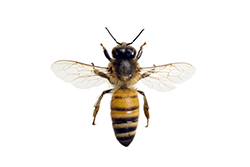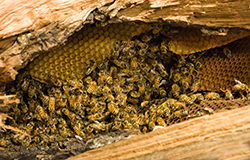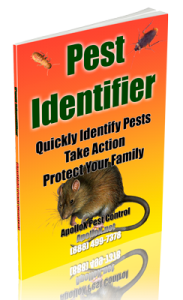Honey Bees Control
Call Now: (888) 499-7378
Schedule an Appointment Online
ApolloX Pest Control will remove honey bees from your home quickly, efficiently, and safely.
Honeybees are social insects found all over the world. They are an extremely beneficial insect because of their role in pollination. Honeybees pollinate more than 100 crops in the U.S.
 Honey Bees Pest Control: Identifying Honey Bees
Honey Bees Pest Control: Identifying Honey Bees
Honey bees have four single wings – two on each side of the body. If you spot an insect with pollen baskets on the hind legs, these are bees. Worker bees are sterile females that measure between 9 and 18mm. They feature a nearly all-black head with a body coloring of golden brown and black with patches of a dull orange. Yellow bands are easily distinguishable on the abdomen and wings are clear. Their entire bodies are covered in tiny hairs with these being most notable on the head an body.
A queen bee can be 18 to 20mm in length. Male drones lack stingers and are kept until reproduction is complete. They are then killed and removed from the hive.
Unlike wasps, honey bees create hives out of wax (not a paper-like substance) and only swarm when they are reproducing. The old queen leaves with a portion of the hive while those that stay behind will work with a new queen born in the hive.
 Honey Bees Pest Control: Where Honey Bees Live and Breed
Honey Bees Pest Control: Where Honey Bees Live and Breed
Honey bees will nest in cavities having a volume of at least 4 gallons but prefer cavities around 9 gallons. Honey bees also prefer dark cavities with an easily defended entrance that is at least 9 feet from the ground. Hollowed-out trees are ideal sites. However, honey bees may nest in all sorts of cavities such as inside walls of houses; in or around chimneys; in outbuildings, fences, shrubs, water meters, utility boxes, barbecue grills, and soffits; or under decks.
 Honey Bees Pest Control: Damage, Harm Caused by Honey Bees
Honey Bees Pest Control: Damage, Harm Caused by Honey Bees
Large numbers of bees swarming in a tree in your garden or around your home can be unnerving, especially if they establish a hive within your house. While they may look frightening, bees that are swarming and carrying honey from their old hive are much less defensive or likely to sting than they would be if they were protecting brood (immature bees) at the old hive. They shouldn’t pose much danger if left undisturbed but will sting if provoked. Honey bee swarms and nests can be safely managed if you follow careful procedures and get proper help. A clustered swarm of many bees may appear frightening, but most spring swarm clusters of European honey bees are extremely docile.
Once bees become established, they will begin to build combs for rearing brood and storing food. Although colonies may do no structural harm to the building, occasionally they use water to soften Sheetrock and remove it in order to expand the nesting area. Residents then will notice an enlarging damp area on their wall. In a few cases, the bees actually open a hole through the Sheetrock so that foragers escape into the house, annoying or scaring occupants. Finally, if the colony is killed and not immediately removed, honey will ferment and leak through walls and ceilings, causing damage.
Honey Bees Control
Call Now: (888) 499-7378
Schedule an Appointment Online
See Also:















Recent Comments